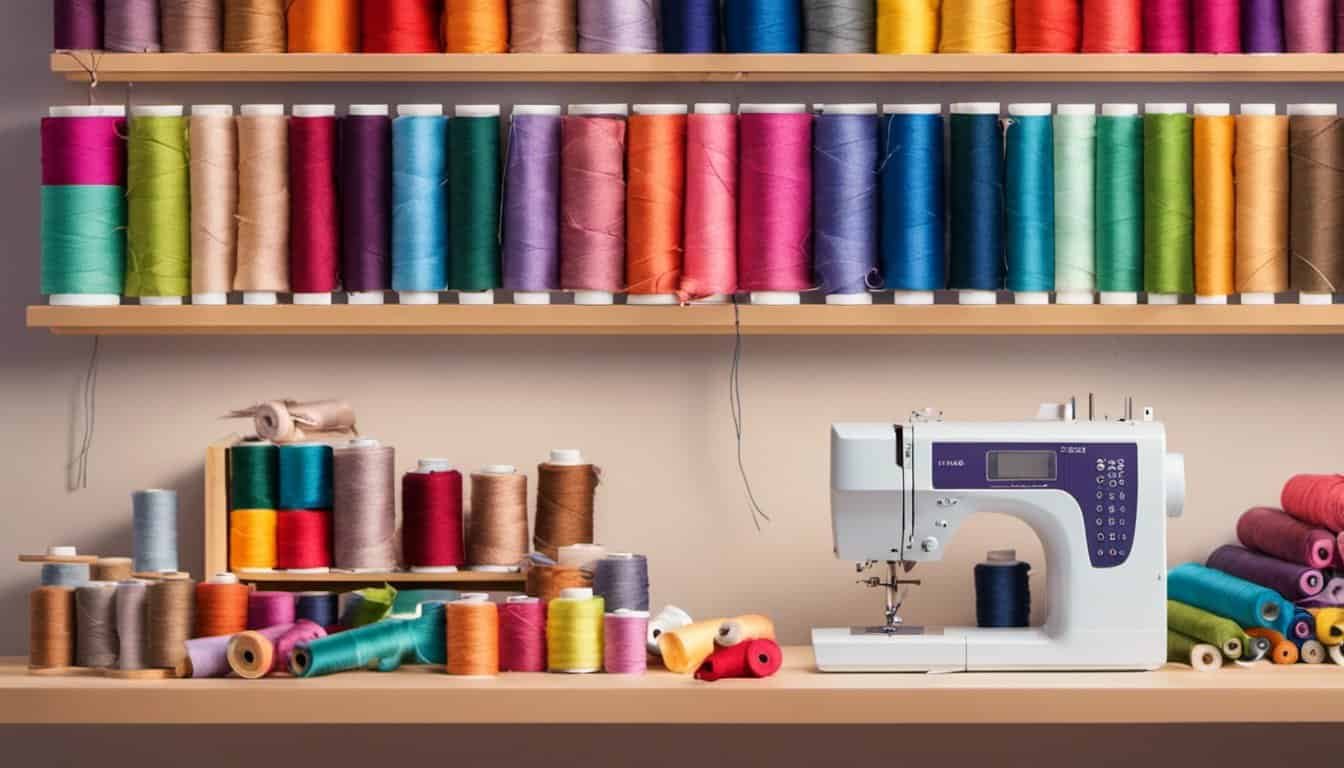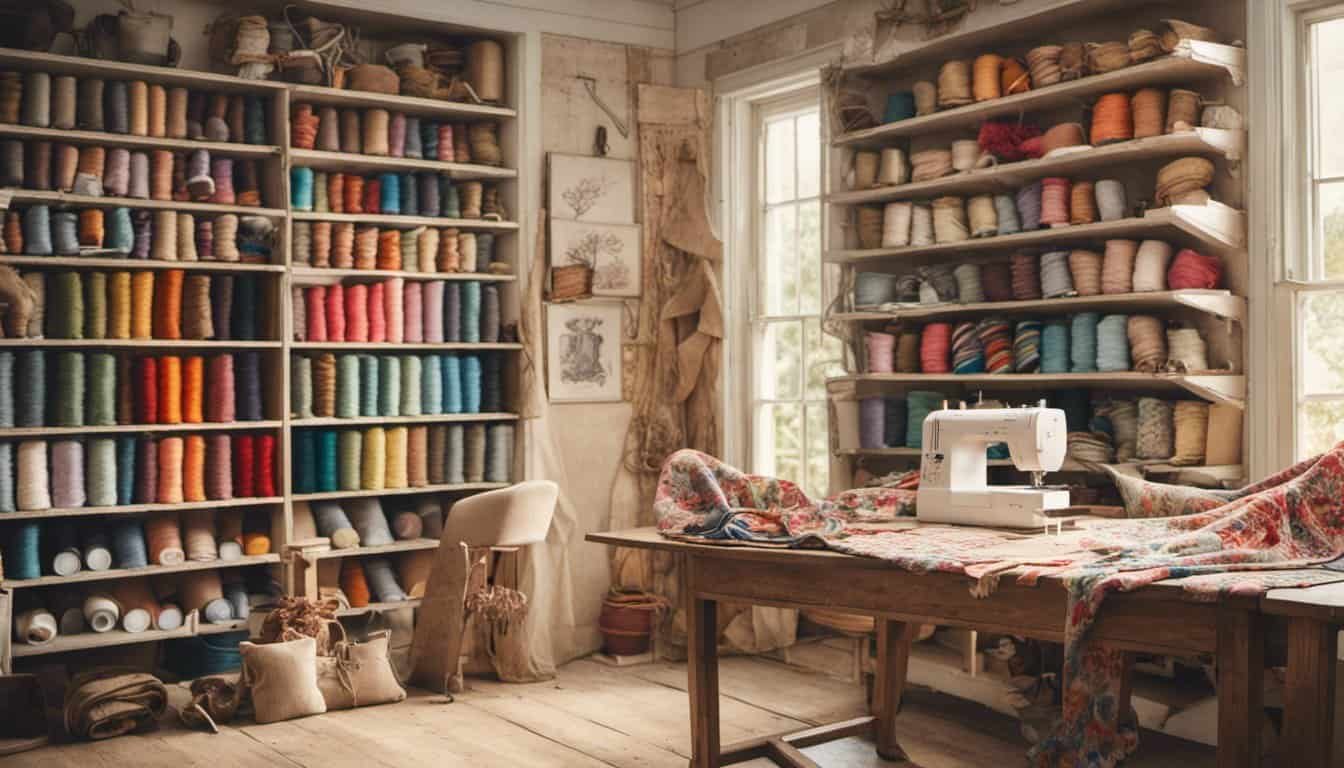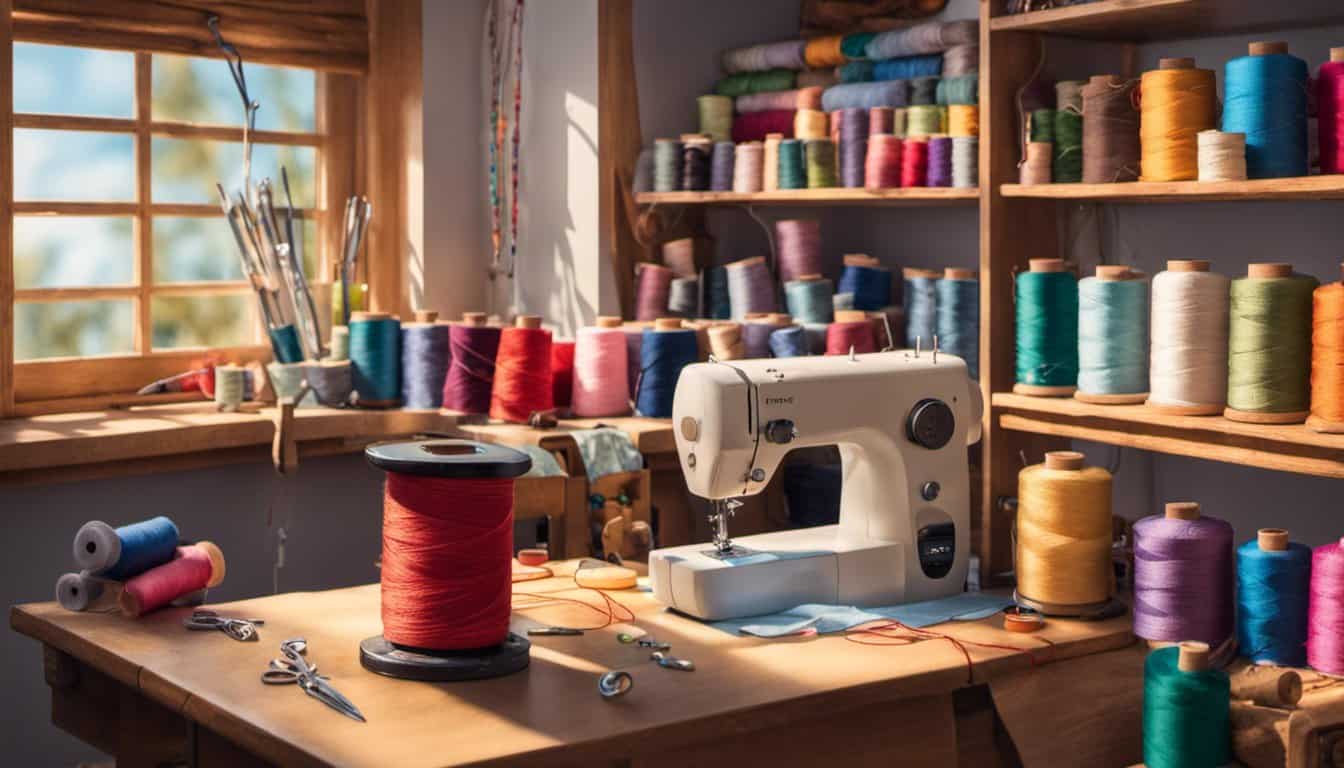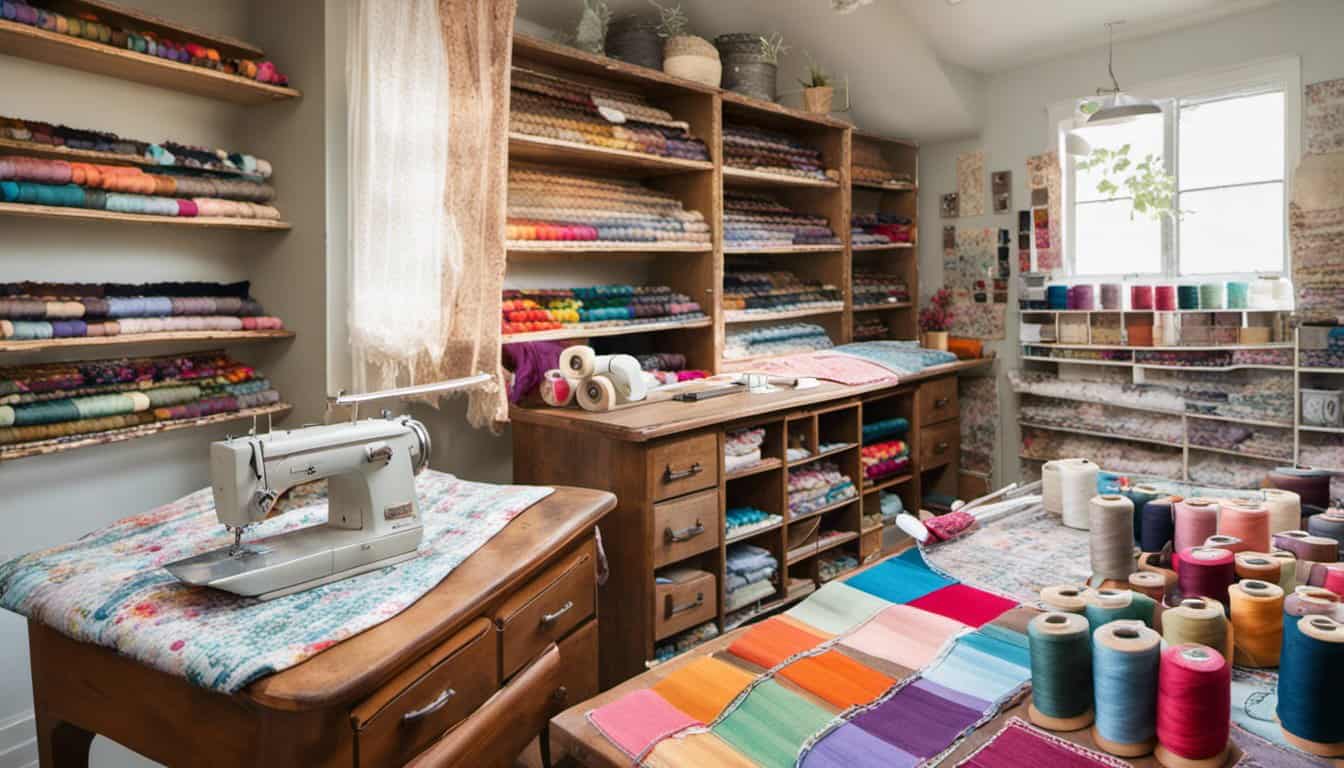Using a handheld sewing machine can be a convenient way to make quick repairs or alterations to your clothing or other fabric items. These machines are small, portable, and easy to use, making them a great option for beginners or those who don’t have a lot of space for a full-sized sewing machine. However, if you’ve never used a handheld sewing machine before, it can be a bit overwhelming to figure out where to start.
In this article, I will guide you through the basics of using a handheld sewing machine, from understanding the different parts of the machine to troubleshooting common problems. We’ll cover everything you need to know to get started, including setting up your machine, working with different fabrics, and maintaining proper tension. Whether you’re looking to make simple repairs or get creative with your crafting, this guide will help you make the most of your handheld sewing machine.
Key Takeaways
- Understand the different parts of your handheld sewing machine and how to set it up properly.
- Learn how to work with different fabrics and maintain proper tension for the best results.
- Troubleshoot common problems and get creative with your crafting using your handheld sewing machine.
Understanding Handheld Sewing Machines
As a sewing enthusiast, I find handheld sewing machines to be a convenient tool for quick repairs or stitching on the go. These mini sewing machines are portable, compact, and easy to use. In this section, I will share some of my experience and knowledge about handheld sewing machines to help you understand their features and how to use them.
Firstly, handheld sewing machines are designed to be lightweight and portable. They are perfect for small projects, such as hemming pants, fixing a tear, or sewing a button. They are also great for beginners who want to learn the basics of sewing without investing in a full-size sewing machine.
When choosing a handheld sewing machine, consider its features. Some models, such as the Singer handheld sewing machine or the Sunbeam handheld sewing machine, offer more advanced features, such as adjustable stitch length and width, automatic thread cutting, and built-in lighting. Others may be more basic, with fewer features but still convenient for simple repairs.
One of the benefits of handheld sewing machines is their ease of use. They typically come with a user manual that provides step-by-step instructions on how to operate the machine. Before using your handheld sewing machine, make sure to read the manual thoroughly to understand the machine parts and how to load batteries.
When using a handheld sewing machine, it’s important to keep in mind that they are not as powerful as full-size sewing machines. They work best with lightweight fabrics, such as cotton, silk, or polyester. Thicker fabrics, such as denim or leather, may be too difficult to sew with a handheld machine.
Overall, handheld sewing machines are a convenient and affordable option for quick repairs and small projects. With a little practice and patience, you can master the art of using a handheld sewing machine and enjoy the convenience it offers.
Setting Up Your Handheld Sewing Machine
Before you start using your handheld sewing machine, you need to set it up properly. Here are the steps to follow:
Load Batteries
Most handheld sewing machines use AA batteries to operate. Check the manual to see how many batteries you need to load. Make sure you insert the batteries correctly, following the instructions in the manual. Once you’ve loaded the batteries, check that the lock system is engaged to avoid accidentally turning on the machine while threading it.
Set Up the Bobbin
The bobbin is a small spool that holds the thread. To set up the bobbin, first, locate the bobbin compartment. Then, insert the bobbin into the compartment, following the instructions in the manual. Make sure the thread is coming out of the bobbin in the right direction. Once you’ve inserted the bobbin, close the compartment.
Thread the Needle
Threading a handheld sewing machine can be a bit tricky, but with a little practice, you’ll get the hang of it. First, locate the thread guide and the spool pin. Place the spool of thread on the spool pin and pull the thread through the thread guide. Next, locate the needle and thread the needle, following the instructions in the manual. Once you’ve threaded the needle, pull the thread through the needle and leave a tail of about 3-4 inches.
Test the Machine
Before you start sewing, test the machine to make sure everything is set up correctly. Turn on the machine and sew a few stitches on a piece of scrap fabric. Check the tension, the stitch length, and the stitch quality. If everything looks good, you’re ready to start sewing!
Setting up your handheld sewing machine may seem daunting at first, but with a little practice, you’ll be able to do it quickly and easily. Just follow the instructions in the manual, and don’t be afraid to experiment a bit to find the settings that work best for you.
How to Use a Handheld Sewing Machine
Using a handheld sewing machine can seem daunting at first, but with the right knowledge and practice, you’ll be stitching like a pro in no time. In this section, I will provide step-by-step instructions on how to use a handheld sewing machine, including the Singer handheld sewing machine and other brands.
Step 1: Load Batteries or Connect to Power
Most handheld sewing machines use batteries to operate, though some models use a power cord. Before you start sewing, make sure your machine has power. If your machine uses batteries, load them according to the instructions in the manual. If your machine uses a power cord, connect it to a power source.
Step 2: Thread the Machine
Threading a handheld sewing machine is different from threading a regular sewing machine. Follow the instructions in the manual to thread your machine properly. Make sure the thread is securely in place and the needle is threaded correctly.

Step 3: Select a Stitch
Handheld sewing machines typically offer three types of stitches: straight stitch, zigzag stitch, and chain stitch. Choose the stitch that is appropriate for your project.
Step 4: Set the Sewing Plate
The sewing plate is the metal plate on the bottom of the machine that helps guide the fabric. Adjust the sewing plate to the desired width of your seam.
Step 5: Start Sewing
Press the power button to turn on the machine. Hold the machine with one hand and guide the fabric with the other. Use the rotary wheel to control the speed of the stitch. To finish a stitch, backstitch a few stitches to secure the seam.
Step 6: Use the Foot Pedal (Optional)
Some handheld sewing machines come with a foot pedal that allows you to control the speed of the stitch with your foot. If your machine has a foot pedal, connect it to the machine and use it to control the speed of the stitch.
Step 7: Use the Presser Foot (Optional)
« Best Sewing Machine Foot Control: Top Picks for Smooth and Precise Sewing
How Much Is a Monogram Machine? Find Out the Cost of Owning Your Own Monogramming Equipment. »
Some handheld sewing machines come with a presser foot that helps hold the fabric in place while sewing. If your machine has a presser foot, attach it to the machine and use it to hold the fabric in place while sewing.
Using a handheld sewing machine can be a convenient way to stitch on-the-go or for small projects. With these step-by-step instructions and sewing techniques, you’ll be able to use your handheld sewing machine with ease and confidence.
Working with Different Fabrics
When it comes to using a handheld sewing machine, working with different fabrics can be a bit tricky. However, with a little bit of practice and patience, you can easily sew through various types of fabrics. Here are a few tips that I find helpful when working with different fabrics:
Choosing the Right Needle
The first thing to consider when working with different fabrics is the type of needle you are using. For instance, if you are working with denim, you will need a heavy-duty needle that can easily penetrate through the thick fabric. On the other hand, if you are working with lightweight fabrics, you will need a fine needle that can easily glide through the fabric without causing any damage.
Adjusting the Tension
Another important thing to consider when working with different fabrics is the tension of your handheld sewing machine. If the tension is too tight, it can cause the fabric to bunch up or pucker. On the other hand, if the tension is too loose, it can cause the stitches to be too loose and the fabric to fray. Therefore, it is important to adjust the tension according to the type of fabric you are working with.
Using the Right Stitch
Using the right stitch is also important when working with different fabrics. For instance, if you are working with denim, you will need to use a straight stitch or a zigzag stitch that can easily penetrate through the thick fabric. On the other hand, if you are working with lightweight fabrics, you can use a straight stitch or a narrow zigzag stitch that will prevent the fabric from fraying.

Practice Makes Perfect
Lastly, it is important to practice sewing on different fabrics using your handheld sewing machine. The more you practice, the more familiar you will become with the different types of fabrics and the easier it will be for you to sew through them. So, don’t be afraid to experiment and try out different fabrics to improve your skills.
In conclusion, working with different fabrics can be a bit challenging when using a handheld sewing machine, but with the right techniques and a little bit of practice, you can easily sew through various types of fabrics.
Maintaining Proper Tension
One of the most important aspects of using a handheld sewing machine is maintaining proper tension. Tension control is the process of adjusting the tightness of the thread as it passes through the machine. If the tension is too loose, the stitches will be loose and uneven. If the tension is too tight, the thread may break or the fabric may pucker. It is important to understand how to adjust the tension on your machine to achieve the best results.
Most handheld sewing machines have tension disks or tension discs that control the thread tension. These disks are usually located on the top of the machine and can be adjusted using a dial or knob. To adjust the tension, turn the dial or knob to increase or decrease the tightness of the thread.
When adjusting the tension, it is important to test the stitches on a scrap piece of fabric before sewing on your project. This will allow you to see how the thread is behaving and make any necessary adjustments before starting your project.

Another important factor in maintaining proper tension is using the correct type of thread for your project. Different types of thread have different thicknesses and textures, which can affect the tension. Be sure to use the correct type of thread for your project and adjust the tension as needed.
In summary, maintaining proper tension is crucial for achieving professional-looking stitches with your handheld sewing machine. Understanding how to adjust the tension using the tension disks or tension discs, testing the stitches on a scrap piece of fabric, and using the correct type of thread will help you achieve the best results.
Troubleshooting Common Problems
When using a handheld sewing machine, it is common to encounter a few problems. Here are some common problems you may encounter and how to troubleshoot them:
Needle not stitching
If the needle is not stitching, check to ensure that the needle is in the correct position. You can do this by checking the needle position and making sure it is in the correct position. If the needle is not in the correct position, adjust it until it is in the correct position. You can also try changing the needle if it is dull or bent.
Thread tension problems
If you are experiencing thread tension problems, try adjusting the tension dial on the machine. If the tension is too tight, the thread will break or the fabric will pucker. If the tension is too loose, the stitches will be loose and may even come undone.

Machine not turning on
If the machine is not turning on, check to ensure that the batteries are inserted correctly or that the power cord is plugged in properly. You can also try replacing the batteries or using a different power outlet.
Fixing plate problems
If you are experiencing problems with the fixing plate, try cleaning it with a soft cloth or brush. If there is any debris or lint on the plate, it can cause the fabric to snag or the stitches to be uneven. You can also try adjusting the plate if it is not in the correct position.
Thread bunching up
If the thread is bunching up under the fabric, check to ensure that the thread is threaded correctly. You can also try adjusting the tension dial or changing the needle if it is dull or bent.
By troubleshooting these common problems, you can ensure that your handheld sewing machine is working correctly and producing high-quality stitches.
Making Repairs and Alterations
When it comes to making repairs and alterations, a handheld sewing machine can be a lifesaver. Whether you need to fix a ripped seam, hem a pair of pants, or make other small repairs, a handheld sewing machine is a convenient and easy-to-use tool.

To get started, gather the materials you’ll need: your handheld sewing machine, a spool of thread, a needle, scissors, and the fabric you’ll be sewing. Once you have everything you need, follow these steps:
Thread the machine: Before you can start sewing, you’ll need to thread the machine. This process will vary depending on the specific model you’re using, so be sure to consult the user manual for instructions.
Position the fabric: Once your machine is threaded, position the fabric you’ll be sewing under the needle. Make sure the fabric is flat and even, and that any edges you’ll be sewing together are lined up properly.
Start sewing: With the fabric in place, you’re ready to start sewing. Use the machine’s trigger or button to start stitching, and guide the fabric along as you go.
Finish the seam: Once you’ve sewn the length of the seam, tie off the thread by making a knot at the end. Trim any excess thread with your scissors.
Hemming pants is a common alteration that can easily be done with a handheld sewing machine. To hem pants, follow these steps:
Try on the pants: Put on the pants and determine how much you need to hem them. Mark the length with a pin or chalk.
Measure and mark: Measure the distance between the bottom of the pants and the mark you made, and add an inch for the hem. Mark this distance all the way around the leg of the pants.
Cut excess fabric: Cut off the excess fabric, leaving about an inch of fabric below the mark.
Fold and pin: Fold the fabric up to create the hem, and pin it in place.
Sew the hem: Using your handheld sewing machine, sew around the hem, making sure to catch both layers of fabric.
With these tips, you’ll be able to make small repairs and alterations quickly and easily with your handheld sewing machine.
Using Your Handheld Sewing Machine for Crafts
I love using my handheld sewing machine for quick and easy craft projects. It’s perfect for making small repairs or adding decorative touches to clothing and household items. Here are some tips for using your handheld sewing machine for crafts:
Choosing the Right Materials
When using a handheld sewing machine for crafts, it’s important to choose the right materials. Thicker fabrics like denim and canvas can be difficult to sew with a handheld machine, so it’s best to stick to lighter fabrics like cotton or linen. You should also choose thread that matches your fabric for a seamless finish.

Simple Crafts
There are so many simple crafts that you can make with a handheld sewing machine. Here are a few ideas to get you started:
- Create decorative patches to add to clothing or bags
- Make a fabric bookmark
- Sew a simple drawstring bag
- Hem a pair of pants or skirt
- Create a fabric headband
Tips for Success
Using a handheld sewing machine for crafts can take some practice, but with a few tips, you’ll be sewing like a pro in no time:
- Practice on scrap fabric before starting your project
- Keep your machine clean and well-oiled
- Use a stabilizer or interfacing to help your fabric stay in place
- Take your time and go slowly to avoid mistakes
Overall, using a handheld sewing machine for crafts can be a fun and rewarding experience. With a little bit of practice and some creativity, you can create beautiful and unique items that you’ll be proud to show off.
Advantages and Disadvantages of Handheld Sewing Machines
As someone who has used both traditional sewing machines and handheld sewing machines, I can attest that each has its own set of advantages and disadvantages. Here are some of the pros and cons of using a handheld sewing machine:
Advantages
Affordable
One of the biggest advantages of handheld sewing machines is that they are generally more affordable than traditional sewing machines. This makes them a great option for those who are just starting out with sewing or who don’t want to invest a lot of money in a sewing machine.

Durable
Despite their small size, handheld sewing machines are surprisingly durable. They are built to withstand the wear and tear of regular use, and many models come with warranties to ensure that they last for a long time.
Battery-Operated
Many handheld sewing machines are battery-operated, which makes them incredibly convenient to use. You don’t need to worry about finding an outlet or dealing with cords, which makes them great for taking on the go.
Disadvantages
Limited Functionality
One of the biggest disadvantages of handheld sewing machines is that they have limited functionality compared to traditional sewing machines. They are best suited for small projects and repairs, and may not be able to handle larger or more complex sewing tasks.
Not as Precise
Handheld sewing machines may not be as precise as traditional sewing machines, which can make it difficult to achieve professional-looking results. This is especially true if you are working with delicate fabrics or intricate designs.
Not as Automatic
Unlike traditional sewing machines, which can be set to automatically stitch a certain way, handheld sewing machines require you to manually guide the fabric and control the stitching. This can be more time-consuming and require more skill and practice to master.

Overall, handheld sewing machines can be a great option for those who want an affordable, portable, and durable sewing machine. However, they do have some limitations compared to traditional sewing machines, so it’s important to consider your sewing needs and preferences before making a purchase.
Frequently Asked Questions
How do I thread a handheld sewing machine?
Threading a handheld sewing machine is a simple process. First, make sure that the machine is turned off. Next, locate the thread guide and thread tensioner. Follow the instructions in the manual to guide the thread through the machine and needle. Once the thread is in place, turn on the machine and test the stitching on a scrap piece of fabric.
What kind of fabric can I sew with a handheld sewing machine?
Handheld sewing machines are best suited for lightweight fabrics such as cotton, silk, and polyester. They may not be able to handle thicker materials like denim or leather. It’s important to check the machine’s specifications and limitations before attempting to sew on a particular fabric.
Can a handheld sewing machine sew through multiple layers of fabric?
While handheld sewing machines are capable of sewing through multiple layers of fabric, it may require more effort and patience than a traditional sewing machine. It’s important to go slow and steady when sewing through thick layers to avoid damaging the machine or the fabric.
What type of stitch can I make with a handheld sewing machine?
Handheld sewing machines typically offer a basic straight stitch. Some models may also have a zigzag stitch option. It’s important to refer to the manual for instructions on how to adjust the stitch length and width.

How do I troubleshoot my handheld sewing machine if it’s not stitching properly?
If your handheld sewing machine is not stitching properly, there are a few things you can try. First, check to make sure that the machine is threaded correctly. Next, adjust the tension settings and stitch length. If the problem persists, refer to the manual for troubleshooting tips or contact the manufacturer for assistance.
Are handheld sewing machines a good option for beginners?
Handheld sewing machines can be a good option for beginners who are just starting out and want to practice basic sewing skills. They are affordable, portable, and easy to use. However, they may not be suitable for more complex projects or heavy-duty sewing tasks. It’s important to consider your specific needs and goals before investing in a handheld sewing machine.


















